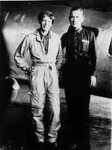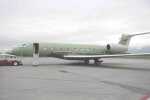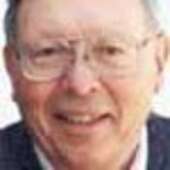Opinion
Amelia Earhart
Monday, July 16, 2012

Earhart and Noonan.
July, 2012 marks the 75th year of the disappearance of Amelia Earhart, at the time, the world's foremost woman in aviation in 1937. Ms. Earhart, who was already the holder of most of the records for women in aviation, was attempting to become the first woman to circumnavigate the globe in an airplane. During this flight, radio contact with Ms. Earhart was lost, and it was presumed that she crashed at sea, in the vicinity of Howland Island, halfway between Hawaii and Australia, in the central Pacific.
For 75 years details of the Earhart disappearance have remained a mystery, and rumors concerning that last flight have been many in the last 75 years. Several artifacts, reportedly either belonging to Ms. Earhart, or to the Lockheed 10E that she was flying have surfaced, raising as many questions as answers to the mystery. In July 2012 there is a multimillion dollar expedition taking place, which it is hoped will finally determine just what happened to Amelia Earhart and her co-pilot, navigator, Fred Noonan in 1937.
Amelia Earhart, certainly the foremost aviatrix of her day, was born in Abilene, Kansas on July 24, 1897. She initially disliked airplanes, to say nothing of flying a plane. When she was 10 years old her father took her to an air show at the state fair, and offered to take her and her sister for a ride. She promptly refused, saying, "I don't want to fly in that old thing. It is held together with rusty wire." She chose instead to take another ride on the Merry-Go-Round.

Amelia Earhart's Lockheed Electra.
Amelia Earhart was very much interested in the feminist movement, even before it became a popular cause. From an early age she kept a scrapbook of stories about women who had achieved success in a "Man's World," and volunteered as a nurse's aide in a military hospital during World War I.
But her interests in school were mainly in mechanics and mechanical engineering. During this time, she attended an exhibition of combat flying by a World War I flyer and the event completely changed her mind about aviation, It was soon after, in 1920, that she took her first flying lessons. Within the year she was the owner of her first plane.
Ms. Earhart realized early on that it was in aviation that she could make her mark in the world, and at the same time advance the cause of women, in the U.S. and worldwide.

Earlier this summer Scott Buethe, the son of Cactus Chris Buethe, who was one of the performers at the McCook 2012 Buffalo Commons Storytelling Festival, was the Captain of the crew that set a world's record for Business Class Jets, when they flew a g650 Gulfstream, above, from Washington, D.C. to Geneva Switzerland in 6 hours 56 min., a distance of 3,780 miles. Said Scott Buethe, "Compared to feats of aviation pioneers, like Charles Lindbergh and Amelia Earhart, this was a piece of cake. Just jump in and go." (Courtesy photo)
From that time, to the end of her days, she was constantly in search of flying records that she could shatter.
In 1928, Ms. Earhart became the first woman to fly across the Atlantic (as a crew member), barely one year after Charles Lindbergh made his historic flight. In 1932, she became the first woman to fly solo across the Atlantic, from Newfoundland to Ireland in 14 hours, 56 minutes.
Upon her return, she was treated to the "Hero's New York Ticker Tape Parade" and newspapers began to refer to as "The Lady Lindy."

A map of Amelia Earhart's route.
For her achievement, she became the first woman to receive the Distinguished Service Cross.
During the early, 1930s Amelia Earhart was a bona fide hero to the American public, on a par with the likes of Madame Curie and Babe Ruth -- even President Roosevelt -- at a time when the American public was in dire need of heroes, in the depths of the Great Depression. She was the aviation editor of "Cosmopolitan Magazine," and the author of two popular books, which covered her exploits in the air. In 1931 she became the first President of the Ninety Nines, The International Organization of Women Pilots (There were 99 original 99 Charter Members).
And always and forever, she was an advocate of Women's Rights.
In 1935, Amelia Earhart summed up her ideas for the women's movement in a letter to her husband, George Putnam (heir to the George Putnam's Sons Publishing fortune), "Women must TRY to do things, as men have tried. When they fail, their failure must be but a challenge to others! In that same letter she stated that she felt that she had one more good flight in her, and after that she would like to retire.
That one last flight was to be a record flight of the first woman to circumnavigate the globe in a plane. Preparations began in earnest in 1936. The flight was to be sponsored by Purdue University, and promoted by her husband, George Putnam.
To prepare charts of her route, she chose Fred Noonan, as her navigator. Mr. Noonan was a longtime ship's captain and was very familiar with routes across the Pacific, having recently plotted the routes for Pan Am Airline Trans-Pacific Air Routes.
In March 1937 Earhart took off from Oakland, California, to Honolulu, Hawaii, on the first leg of her trip around the world, a trip that was eagerly covered by most of the major newspapers of the world.
That first flight was successful, but when she took off from Honolulu, on the second leg of the flight, a tire blew out and the landing gear collapsed, causing the plane to ground loop. The damage was extensive enough that the plane had to be shipped back to the US for repairs.
In June 1937, Earhart made a second attempt at her flight around the world. This time she traveled West to East, making numerous stops in South America, Africa, India, and Southeast Asia, arriving in Lae, New Guinea on June 29, 1937. At this point she had completed 22,000 miles of her trip, with only 7,000 miles remaining -- however all of those 7,000 miles would be over the Pacific Ocean.
On July 2, 1937, Earhart and Noonan took off for Howland Island, a tiny dot in the Pacific, almost exactly halfway from Australia to Hawaii. Plans called for the pair to refuel at the rudimentary grass runway airfield in the center of the island -- the runway was constructed in anticipation that the island might be used by various trans-Pacific routes in the future.
Though fuel was available for the Earhart-Noonon flight, the pair never reached Howland Island. Some clues surfaced that for reasons unknown, they had missed Howland Island, and had crash landed on Gardner Island, uninhabited for 40 years, and some 400 miles from Howland.
There is some evidence that the pair might have survived for some time on Gardner, sending out weak radio transmissions, before they succumbed to the elements. Hopefully, the current Earhart expedition will uncover definitive clues to one of the world's great mysteries.
A few of the flying records that Amelia Earhart achieved:
Women's World Altitude Record, 14,000' 1922
First woman to fly across the Atlantic ocean 1928
World's speed record for women (181.18 mph) 1930
Altitude record for autogyros (forerunner of the helicopter) 1931
First person to cross U.S. in an autogyro 1932
First woman to fly across the Atlantic solo 1932
First woman to fly non-stop across the US 1933
Women's Transcontinental speed record across US 1933
First person to fly solo Hawaii to California 1935
First person to fly solo Mexico City to New York 1935
Speed record, flying California to Hawaii 1937
Source: Earhart Timeline, Amelia Earhart Bio.

